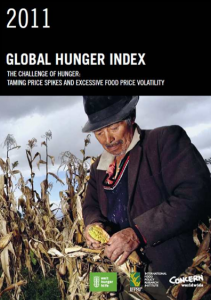Resource Title
2011 Global Hunger Index: taming price spikes and excessive food price volatility
Summary
Now in its 5th edition, the Global Hunger Index has become the standard for tracking trends in the comparative levels of hunger in different parts of the world and across individual nations.
Organised annually by a leading theme, the 64 page report is designed for policymakers, antipoverty workers and advocates and is driven by two factors: the need for information (on how and why hunger is occurring) and the need for action (addressing the short, medium and long term causes of hunger).
According to the 2011 Index, 26 countries have levels of hunger that are alarming or extremely alarming, and all those with extremely alarming levels – Burundi, Chad, the Democratic Republic of Congo, and Eritrea – are in Sub-Saharan Africa.
Resource Details
Description
Now in its 6th edition, the Global Hunger Index is a joint research report by Concern Worldwide, the International Food Policy Research Institute (IFPRI) and German NGO Welthungerhilfe. The Global Hunger Index report ranks countries on three leading indicators:
- prevalence of child malnutrition;
- rates of child mortality;
- and the proportion of people who are calorie deficient
The indicators are then combined into one score. The higher the score, the more desperate the predicament of those affected. The Index is calculated for 122 developing and transition countries for which data on the three components of hunger are available.
The report is packed full of case studies, individual testimonies, beautifully laid out tables, maps, data sets, photos, illustrations and is ‘educationally friendly.’
Growing demand for biofuels, extreme weather and climate change, and increased financial activity through commodity futures markets are the main causes of high and volatile food prices, according to the 2011 report. These challenges are exacerbated by historically low levels of grain reserves, export markets for staple commodities that are highly concentrated in a few countries, and lack of timely, accurate information on food production, stock levels, and price forecasting, which can lead to overreaction by policymakers and soaring prices.
To tame food price volatility and protect the poor against future shocks, the report makes several policy recommendations focused on the three levels of action:
- Addressing the drivers of food price volatility;
- Tackling global market characteristics affecting volatility, including building up stocks by coordinating international food reserves and sharing information on food markets; and
- Building resilience for the future.
Available from:
- Download 2011 Global Hunger Index PDF
- Download 2011 GHI briefing paper PDF
- Download 2011 GHI World Map PDF
- Link to video introducing the 2011 GHI (Youtube)

